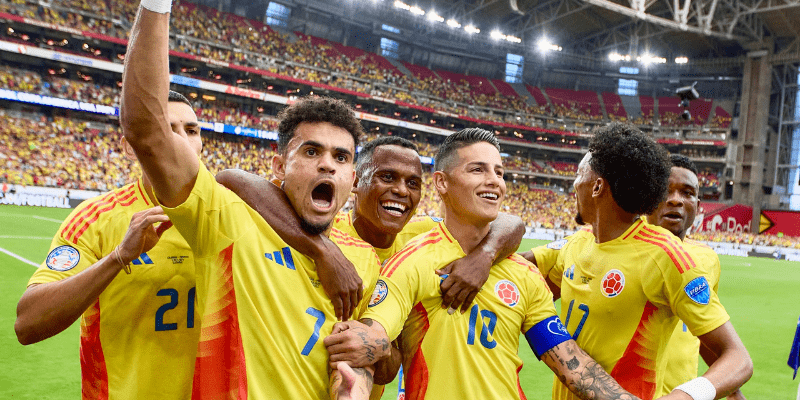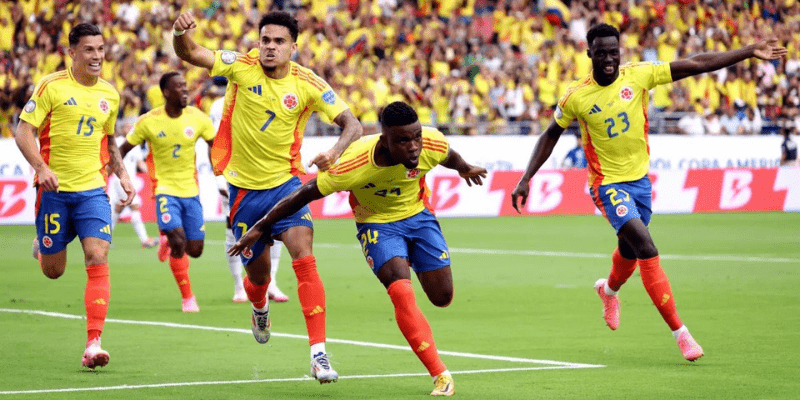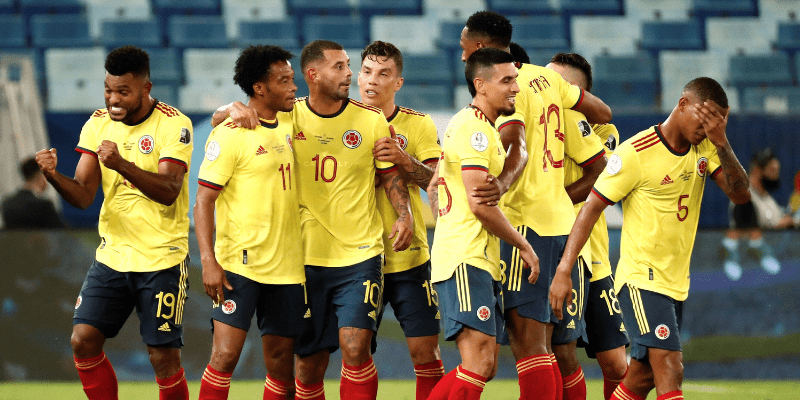The roar of expectation, the shiver of tension, the mounting thrill of “How long can this last?” — for Colombian fans, those questions became a daily heartbeat over the last couple of years. Colombia longest unbeaten run isn’t just a statistical footnote: it’s a story of revival, identity, belief, and a national team reasserting itself on the world stage. In this article, IndiGoal will take you behind the scenes of that epic streak: how it began, the key matches, the heroes, the historic context, and finally, its closure and legacy.
The Rise Begins:

- Before 2022, Colombia’s national team experienced mixed results: inconsistency in qualifiers, tournament exits, and pressure.
- The turning point came with the appointment of Néstor Lorenzo in June 2022, a coach who promised tactical cohesion, defensive discipline, and a hunger to build something lasting.
- The last defeat prior to the run was on February 1, 2022, when Colombia lost 1–0 to Argentina in Córdoba. Since then, the foundations of resilience were laid.
- In the early phase, Colombia tightened up at the back, leaned on experienced players like James Rodríguez and David Ospina, and wove in rising talents who bought into a collective ethos.
As the results rolled in — draws, narrow wins, dominant performances — confidence accumulated. The streak was no accident; it was the result of a new philosophy taking root.
Anatomy of the Streak: 28 Matches Without Defeat
Match Record Breakdown
The team-recorden run lasted 28 matches before being ended.
Here’s how those 28 games split:
- Wins: 22
- Draws: 6
- Losses: 0 (until the streak ended)
- The run spanned, ending in the Copa América 2024 final against Argentina.
Key Milestone Matches
To understand how this run wasn’t just luck, look at some standout results:
- Colombia 1–0 Uruguay (Copa América semi): This win sealed the 28th match unbeaten and sent them to the final.
- Colombia 2–1 Paraguay (Copa América group stage): With this win, Colombia extended their run into the mid-20s.
- Colombia 5–0 Panama (Quarterfinal): A statement win, which also equaled the old record of 27 matches unbeaten.
- Friendlies and qualifiers included wins over major footballing nations (e.g. Germany, Brazil, Spain) during the run. kipedia])
How It Compared to Past Records
- The previous best by Colombia was 27 matches unbeaten, recorded under Francisco Maturana from 1992 to 1994 — a golden generation led by Valderrama, Asprilla, and others.
- Thus, the 28-match stretch isn’t just new — it shattered the national record. Colombia One])
- In terms of global context, the run placed Colombia among the elite: while not the longest ever, a 28-match unbeaten run is extraordinary in modern international football.
This wasn’t a fluke — it was one of the strongest sustained periods in Colombia’s football history.
Inside the Streak: Philosophy, Tactics, and Culture

What made this run possible wasn’t just players or fixtures — it was a shift in everything.
Defensive backbone + pragmatic offense
- Under Lorenzo, the team adopted a compact defensive shape, minimizing space for opponents and placing high value on transition counters
- They didn’t always need to dominate possession; often, they absorbed pressure and struck when opportunities came.
- In many matches, the difference came from individual brilliance or set-piece efficiency, rather than dominant ball control.
Squad unity and rotation
- Depth was critical. Injuries, fatigue, and fixture congestion meant rotations were inevitable — but the team had confidence in backups too.
- Senior leaders — especially James Rodríguez, David Ospina, and experienced defenders — acted as a steadying presence.
- Young blood was integrated with care. The sense was that no matter who played, the “Colombian identity” on the pitch remained consistent.
Psychological resilience
- Blowing leads, defending under pressure, and late goals were challenges during the streak — but the team often found ways to survive or salvage points.
- The belief grew: each game was another chance to extend something bigger than any single match.
- The public and press began to see them not just as hopefuls, but as a dark-horse power in South America.
In short: the streak wasn’t built by magic — it was built on discipline, structure, and collective will.
The End Game: How 28 Unbeaten Met Its Match
Every streak ends — and for Colombia, it came in the most dramatic setting possible.
The Copa América 2024 final
- Date & opponent: July 14, 2024, against Argentina.
- Result: Colombia lost 1–0 in extra time (Lautaro Martínez scored in the 112th minute).
- Up to that moment, they had held Argentina scoreless in regular time — a testament to the solidity they’d built.
- The defeat ended the 28-match unbeaten run, leaving the fans with both pride and heartbreak.
Legacy versus closure
- Even in defeat, the performance was emblematic of everything the streak stood for — grit, resolve, and ambition.
- Instead of detracting, the manner of the loss elevated the run: it became part of a narrative of upward trajectory — not a collapse.
- In football lore, 28 unbeaten now defines a chapter of resurgence for Colombia.
Why The Streak Matters: Impact & Significance
The Colombia longest unbeaten run carried more than just a number — it carried meaning. Here’s why it resonates:
- Renewed national pride
- After periods of underperformance, football fans found something to rally behind again. The streak became a unifying symbol.
- Boost in FIFA & CONMEBOL perception
- Colombia’s weight in South America shifted. Opponents began to treat them as serious title contenders and threats in every match.
- Confidence in next cycle
- For the upcoming World Cup cycles, roster decisions, preparations, and mental frameworks now have a base of belief to build on.
- Historical benchmark
- Future Colombian teams will be measured against this run. Will someone surpass 28 someday? It’s now the benchmark.
- Tactical blueprint
- Lorenzo’s approach — defensive solidity, strategic counterattacks, squad depth — has become a template many believe Colombia should preserve.
In short: the streak was more than results. It was identity, narrative, and a springboard forward.
Colombia’s Streak in the Global Context
Where does 28 unbeaten stand in the pantheon of international football?
- The all-time record is held by Italy, with a 37-match unbeaten run (2018–2021).
- Others like Brazil, Spain, or Argentina have had long unbeaten spells (30+), but in modern football, few sustain such consistency.
- For a CONMEBOL team, where qualifiers are brutal, cups are high-stakes, and travel & altitude play roles, running 28 without defeat is especially remarkable.
Colombia’s run doesn’t “break the world record” — but it stands among the elite in modern football achievements.
Lessons and Legacy: What Colombia Must Do Next

A streak, no matter how glorious, is finite. The future demands transformation.
- Maintain core philosophy: The structure and identity built during the streak should not be discarded.
- Integrate new talent: Young players must be smoothly folded in without diluting the “team DNA.”
- Manage expectations: The public will expect titles now. Pressure must be channeled, not crushed.
- Learn from the final loss: Margins in finals are thin — tactical, mental, set-piece, substitution decisions all matter.
- Aim higher: The next goal isn’t to equal 28 — it’s to surpass it, to win continental titles, to build a global reputation.
If the streak was the foundation, what Colombia builds on it will define a generation.
Conclusion
Colombia longest unbeaten run will forever mark one of the most thrilling and transformative chapters in the history of La Tricolor. Through tactical discipline, collective belief, and unwavering resilience, the team crafted a 28-match stretch that broke records, unified a nation, and redefined expectations. But beyond the numbers, this run planted seeds of ambition for Colombia’s future — a future now measured by how high they can rise.
IndiGoal invites you: revisit every match, debate the choices, celebrate the heroes, and keep your eye on what comes next. Want match-by-match stats, player ratings, or comparisons with other footballing greats’ unbeaten runs? Drop a comment — we’ll keep exploring this journey together.






